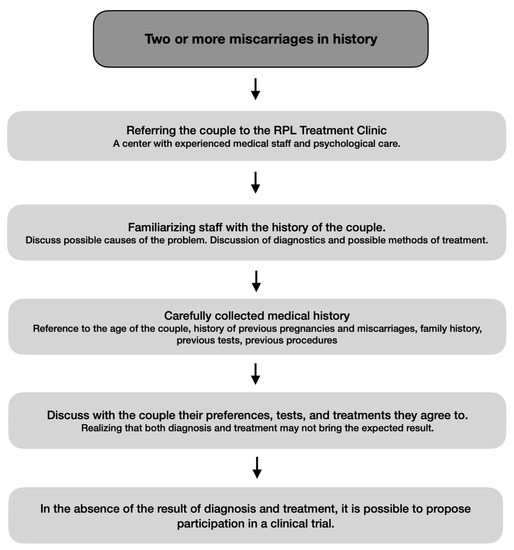You're using an outdated browser. Please upgrade to a modern browser for the best experience.
Please note this is a comparison between Version 1 by Dorota Darmochwal-Kolarz and Version 2 by Conner Chen.
Recurrent pregnancy loss is a common problem in the reproductive age population of women. It can be caused by many different conditions. This problem is addressed in international guidelines that take a slightly different approach to its diagnosis and treatment.
- recurrent pregnancy loss
- RPL
- pregnancy
1. Introduction
Recurrent pregnancy loss (RPL) is a common problem in the reproductive age population of women. It is a challenging clinical issue associated with psychological aspects. Miscarriages are very difficult for patients, their partners and clinicians. The management of the problem can be different; it depends on the cause of RPL. This issue was considered in guidelines published by the Royal College of Obstetricians and Gynaecologists (RCOG) in 2011 [1], American Society of Reproductive Medicine (ASRM) in 2012 [2] and European Society of Human Reproduction and Embryology (ESHRE) in 2017 [3][4][3,4]. All guidelines define several causes of recurrent pregnancy loss such as parental genetic disorders, uterine anatomical malformations, problems with the endocrine system, hemostatic dysfunctions and others. Many causes of miscarriages are being found, and it can be treated, but still, about 50% of RPL cases remain unexplained.
2. Definition of Recurrent Pregnancy Loss
A definition of miscarriage presented by the Royal College of Obstetricians and Gynaecologists guidelines, which were published in 2011, is a spontaneous loss of pregnancy in the uterus before the fetus reaches viability. It means that miscarriage happens until the 24th week of gestation. RCOG, in their Green-top Guideline No. 17, says that RPL is a miscarriage of three or more pregnancies. Moreover, the updated guideline states that miscarriages do not have to be consecutive to be defined as recurrent pregnancy loss. It affects 1% of couples trying to have a child. It is estimated that 1–2% of pregnancies in the second trimester of pregnancy will miscarry before the 23rd week and the 6th day of pregnancy [1][5][1,5]. The proposed definition of RPL is based on earlier research from 1990 published in The Lancet, which summarizes the results of epidemiological studies. The Lancet suggests that data should be collected up to 28 weeks of gestation, but it should also be possible to assess up to 20–22 weeks or a 500 g fetal weight [6]. In 2012, a publication of the American Society of Reproductive Medicine gave a definition of RPL as a miscarriage of two or more failed clinical pregnancies. ASRM estimates that the loss of two pregnancies will happen to 5% of women, and the loss of three or more pregnancies happens to about 1% [2]. The ESHRE from 2017 defines RPL as two or more pregnancies that do not have to be consecutive [3][4][3,4]. Another aspect of miscarriage that should be considered is how we understand the definition of pregnancy. ASRM includes in its definition the importance of ultrasounds and the histological confirmation of pregnancy [2], whereas the RCOG understands pregnancy from conception, which means that it includes biochemical pregnancy [1]. In ESHRE’s opinion, pregnancy needs confirmation with the use of serum or urinary chorionic gonadothropin, and it does not include ectopic and molar pregnancies [3][4][3,4]. It is important to consider because the risk of losing biochemical pregnancies is higher than that of losing clinical pregnancies (22% vs. 0.3%) [7]. ESHRE, to provide the definition, used the results of a study by van den Boogaard et al. in 2013 on whether the pregnancy losses are consecutive or whether two versus three losses are not associated with the risk of antiphospholipid syndrome (APS) [8], research by van den Boogaard et al. in 2010 which states that there is no difference in the possibility of carrier status (of a structural chromosomal abnormality) between couples who had two or three consecutive pregnancy losses and those who had two or three non-consecutive losses [9] and the study by Egerup et al. in 2016, which showed that there is some proof that whether the pregnancy losses are consecutive or not has an impact on prognosis in unexplained RPL [10]. There are some other definitions of recurrent pregnancy loss. One of them was offered by the French National College of Obstetricians and Gynecologists (CNGOF) in 2016. The CNGOF defines RPL as a history of three consecutive (or more) early miscarriages before the 14th week of gestation [11]. Another definition was accepted by the consensus of German Society of Gynecology and Obstetrics (DGGG), the Austrian Society of Gynecology and Obstetrics (ÖGGG) and the Swiss Society of Gynecology and Obstetrics (SGGG). The DGGG, the ÖGGG and the SGGG adopt the definition presented by the WHO, which defines recurrent pregnancy loss as three consecutive miscarriages before 20 weeks of gestation [12]. RPL definitions used in individual guidelines are compared in Table 1 [1][2][4][1,2,4].| RCOG (2011) | ASRM (2012) | ESHRE (2023) |
|---|---|---|
| Three or more failed pregnancies Do not have to be consecutive |
Two or more failed clinical pregnancies | Two or more failed pregnancies Do not have to be consecutive |
| Clinical pregnancy, also includes biochemical pregnancy |
Ultrasound and histological confirmation of pregnancy | Confirmation by serum or urinary chronic gonadothropin Do not include ectopic and molar pregnancies |

